Spring planting of a fruit tree in open ground: how to plant seedlings correctly
Probably at the moment you are in search of information about the timing and rules for spring planting a seedling of a fruit tree in your garden or summer cottage, right?
In the European part of Russia (Central Russia), as well as in Siberia and the Urals, almost all fruit crops can be successfully grown: apple, pear, quince (= pome fruits), cherry, sweet cherry, plum, cherry plum, blackthorn, as well as dogwood and hawthorn (= stone fruit). Not always, unless the thermophilic apricot and especially the peach succeed (they simply freeze out).
Below you will find general guidelines and tips on when and how to plant fruit trees in the spring.

Content
- 1 When to plant fruit trees in spring: when
- 2 Selection and preparation of a seedling for planting
- 3 How to properly plant a seedling in open ground
- 3.1 Landing place
- 3.2 Distance between seedlings (planting pattern)
- 3.3 The need for pollination
- 3.4 Landing pit dimensions: when and how deep to dig
- 3.5 How to fill the landing hole
- 3.6 How deep to plant (how not to bury)
- 3.7 Direct planting of a seedling in a hole
- 3.8 Pruning after planting
- 3.9 Features of planting a seedling in a container (with ZKS)
- 4 How to care for a seedling after planting
When to plant fruit trees in spring: when
The optimal period for planting a fruit tree is early spring. Moreover, the seedling must be "at rest", in other words, sleep, because the kidneys should still be closed (albeit already swollen, but not green).
As for weather conditions, the air temperature should be above zero both during the day (preferably +5) and at night.
Advice! Open-root seedlings are very good at planting immediately after the snow melts while the ground is still damp.
As for the approximate dates, depending on the climatic characteristics of the region, spring planting is carried out from April to early May.
By the way! The best time to plant seedlings is cloudy and calm weather: early morning or late evening.
Terms for regions
Obviously, depending on the climatic characteristics of the region and the current weather conditions, the timing of the spring planting of fruit trees will differ:
- In the southern regions, planting begins in March-April.
- In the Middle Polos (Moscow region), seedlings are planted not earlier than the second half of April.
- In Siberia and the Urals, spring planting is carried out only in late April and early May. Around the same time, trees are planted in the North-West (in the Leningrad region).
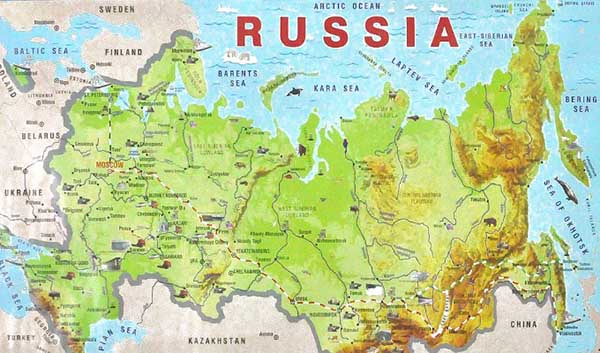
According to the lunar calendar for 2021
If you want to choose a specific date for planting a fruit seedling in open ground, then this can help you moon calendar.
So, most auspicious days for spring planting of seedlings of fruit crops in 2021, according to the lunar calendar, are:
- in March - 26-29;
- in April - 11-15, 24, 25;
- in May - 2-10.
Of course, it is not always possible to come to the dacha and plant a seedling on an auspicious day. However, the main thing is not to do this on unfavorable days (and these are the days of the Full Moon and New moons, as well as the period when the Moon is in Aquarius, because it is a barren and dry sign - italicized).
Unfavorable days according to the lunar calendar for 2021, the following dates for planting seedlings of fruit trees in spring are:
- in March - 9-10, 13, 28;
- in April - 5-6, 12, 27;
- in May - 2-4, 11, 26, 30-31.
When is it better - in spring or autumn
Many gardeners agree that in the spring you can plant any fruit crops, while in the fall you can leave only frost-resistant varieties.
Thus, for example, apple and pear (seed crops) are planted both in spring and autumn. But less winter-hardy stone fruit crops (cherry, sweet cherry, plum, cherry plum, apricot, peach) should be planted in the spring, so that before winter they have time to take root well and get stronger.
Note! Seedlings with a closed root system (in a pot) can be planted all year round - from April to October. Is it not recommended to do planting in the middle of summer (in July), when it is very hot.
Selection and preparation of a seedling for planting
The choice of planting material must be approached with all responsibility. At the same time, it is best to buy seedlings in nurseries, but not in spontaneous markets.
So, it is recommended to purchase only zoned varietieswho have sufficient the level of winter hardiness for the climate of your region.
Saplings are of 2 types:
- With an open root system (OCS);

- With a closed root system (in a container).
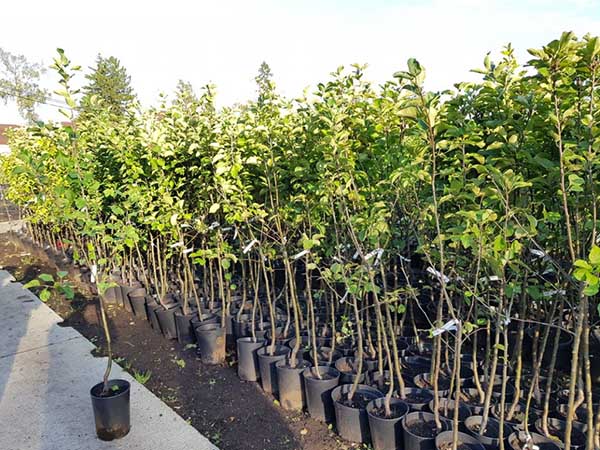
Of course, it is better for beginners to take seedlings in a container (they are much more expensive), and experienced gardeners can also buy them with ACS.
A quality seedling with an open root system has the following characteristics:
- Age - not older than 3 years, (the best choice is 2-year-old seedlings).
- Overall healthy appearance, without any signs of wilting, damage by diseases or pests.
- Height within 1-1.5 m (any deviation up or down indicates improper care of it or excessive application of nitrogen-containing fertilizers).
However! Sometimes sellers sell cut seedlings straight away, but this is rare.
- Powerful branched root system, that is, in addition to the main root, there should be several (2-4) side ones (the older the seedling, the more roots it has), 20-25 cm long, while they should not be overdried and broken (without any growths and neoplasms).
Even if you are buying a seedling with a closed root system, the lateral roots tend to stick out of the container.
Advice! To check that a seedling is indeed with a closed root system, it must be grasped by the trunk and shaken. If he sits tightly - everything is fine, if not, then something is wrong here ... Most likely, a dishonest seller, hungry for profit, put him there a couple of days ago.
- The seedling in the lower part of the trunk is clearly visible vaccination site (rootstock and scion connections), which is a guarantee that this is a varietal tree and not wild.
By the way! As a rule, the vaccination is done method budding (they also say "grafted with an eye"), less often with a handle (ie copulation).
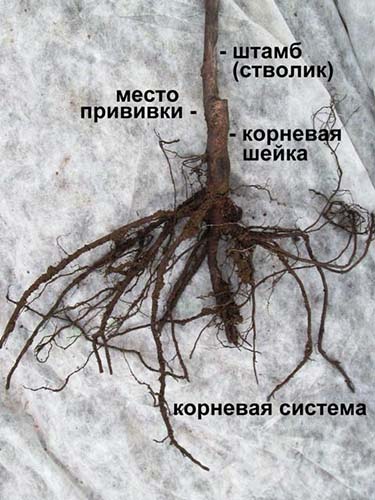
- At the top of the trunk (grafted part), the wood should be ripe and strong, without any mechanical damage, sunburn, frost cracks and cracks in the bark. And you the trunk must be straight and not bent.
Important! It is highly desirable that a seedling with an open root system (ACS) does not have any signs of the beginning of the growing season, i.e. was in a dormant stage (the buds are asleep, there are no leaves).
- Open-root seedling (ACS) ideally should not show any signs of the beginning of the growing season, i.e. be in a dormant stage, in other words, the buds should sleep (no leaves).
Note! Seedlings in containers (with a closed root system) in the spring are usually sold in a vegetative state (with leaves), and this is normal. In this case, you also need to carefully evaluate their appearance, especially the color of the leaves.
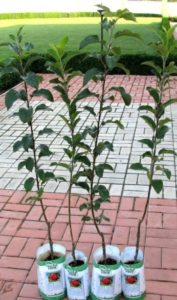
Preparing for landing
Immediately before planting, the roots of the seedling are recommended wash off old soil, then dip in a clay mug, and then update their tipsby cutting slightly.
Important! Moreover, you need to update the tips of the roots if they are too long, as well as in the presence of damage, sore or broken parts (in this case, they need to be trimmed to a healthy place).
And some gardeners even advise to soak the roots of the seedling in water (it is possible in Kornevin's solution) a day or at least an hour before planting. This will help restore biological processes in the roots and saturate them with moisture, especially if you see that the roots are slightly dry (and this should never be allowed).
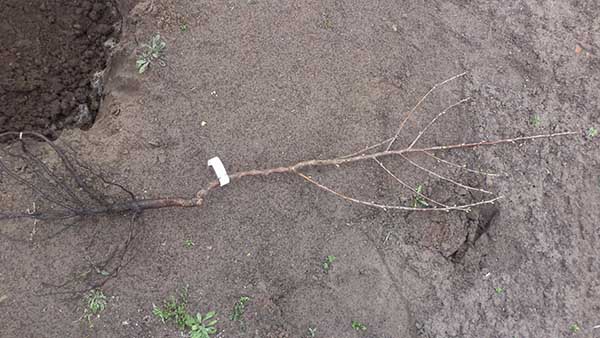
How to properly plant a seedling in open ground
So, first you need to choose the optimal place, decide on the planting scheme (the distance between trees). Next, you should dig a planting hole of the required size, fill it with fertile soil. Shortly before planting, prepare the seedling itself and plant it to the desired depth (without deepening). Now let's talk about each step in detail.
Landing place
All fruit trees love an abundance of light and warmth (= sun rays), especially for southern stone fruits (apricot, peach).
If the place is shady and cold, then this will certainly negatively affect the yield of the crop, and the fruits will not only be few, they will also be tasteless (they will not ripen corny).
Advice! In no case should you plant seedlings of fruit trees next to nuts.
Therefore, in order to create an optimal light regime (correctly positioned to the cardinal points), tall crops (fruit trees) should be placed from the north side of the siteso that their tall and spreading crowns do not shade the shorter ones (the same berry bushes, garden crops).
At the same time, it is advisable to plant more thermophilic stone fruit crops along the fence, various structures on the site, which would protect the trees from the northern drying winter winds and drafts.
Naturally, it is always preferable to plant trees on higher elevations (warmer there) than lowlands (colder and precipitation may accumulate).
The fact is that if you plant a tree in wetland, where moisture stagnates in the spring (after the snow melts and melts), then you are guaranteed root collar support and the future slow death of the tree.
Therefore, if you do not have a choice (there is only a place in a lowland or a swampy corner), then do artificial hill (make a mound) and drop on it.

By the way! It is believed that pome crops (apple and pear) are crops with sufficiently "strong" root collars, in other words, they can grow quite well in the lowlands (in the lower part of the plot). Whereas stone fruits (the same apricots, peaches) have "weak" root collars, so it is better to plant them in the upper part of the site (or on loose mounds).
The information is relevant for the regions of risky farming.
You should also take into account the close location of groundwater, which can cause poor fruiting or even its complete absence.
Accordingly, if the groundwater lies closer than 1.5-2 meters, then you have no choice but to make an artificial embankment and plant a seedling already on a hill.
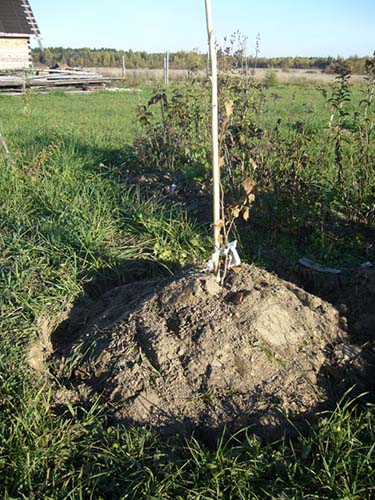 Thus, in a cold and harsh climate, as well as if the land is heavy, or the site is very waterlogged and the groundwater is very close, then any other fruit trees are recommended to be planted on gentle hills ("According to Zhelezov").
Thus, in a cold and harsh climate, as well as if the land is heavy, or the site is very waterlogged and the groundwater is very close, then any other fruit trees are recommended to be planted on gentle hills ("According to Zhelezov").
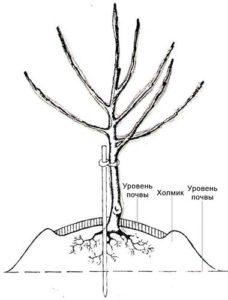
Distance between seedlings (planting pattern)
The layout of trees on the site must be drawn up taking into account their strength of growth and growth of the crown of the variety itself, as well as the stock (on which the variety is grafted).
Remember! The closer you plant trees, the more difficult it will be for you to control their crown in the future, in other words, you will need regular and mandatory pruning, including summer pruning.
On average, trees are recommended to be placed at the following distance from each other:
Apple trees and pears (seed-bearing):
- On a vigorous rootstock - 5-7 meters between rows and 4-5 meters between trees in a row;
- Medium height - 4 m by 3 m;
- Weak (on a semi-dwarf rootstock and on a dwarf) - 3 m by 1.5-2 meters.
By the way! Columnar apple trees are planted according to the scheme: 0.8-1.2 in aisles and 0.5-0.8 m in a row.
Stone fruits (cherries, plums, cherry plums, peaches, apricots) - 3-4 meters between rows and 3-4 meters in a row (depending on the strength of growth).
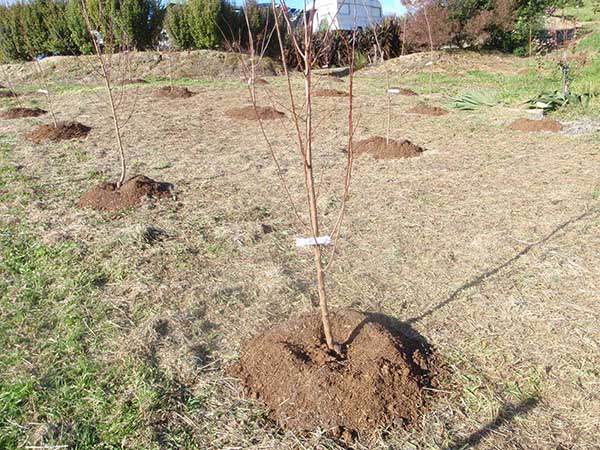
Thus, if you have a small plot (6 acres), then for planting more trees it is better to buy seedlings on low or medium-sized rootstocks.
By the way! Do not forget to retreat from the border of your site (fence) or any structure at least 2 meters.

The need for pollination
For example, cherries, like cherries, require cross-pollination (since the crops themselves are self-fertile), in other words, you need to plant next to at least 2 or better 3 different varieties (the same varieties are not suitable for pollination), and it is necessary one flowering period.
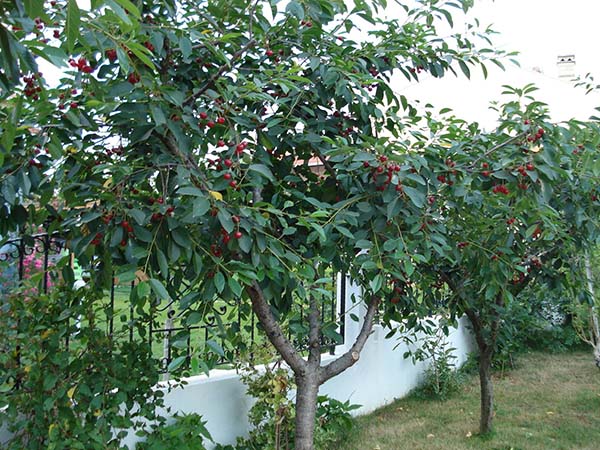
Of course, there are self-fertile varieties that do not require pollination, but for their better pollination, it is still better to have another variety of cherries or cherries nearby.
Advice! Cherry can be planted next to the cherry(excellent pollinators).
Some varieties of the same pears (for example, Moskvichka) also self-infertile, i.e. next to you, you should definitely plant other pollinating varieties (for example, Yakovleva's Lyubimitsa or Moskovsky Bergamot).
Landing pit dimensions: when and how deep to dig
Very important prepare the landing pit in advanceand do it even better from autumn or at least 1-2 weeks before planting the seedling (as early as possible - immediately after thawing the soil) so that the loose soil mixture has time to settle to the desired level and is sufficiently compacted.
Now you need to decide on the size of the landing pit. As a rule, they dig a hole with a diameter (width) of 60-100 cm and a depth of 60-80 cm (on average, it is optimal to make 60 by 60 cm).
If your earth is claythen dig a hole wider and deeper (80-100 cm in diameter and 70-80 cm deep).
If you plant seedling in a pot (with closed root system)then landing pit you can just do 2-3 times larger than the container itself (earthen lump).
When you dig a hole, do not forget to fold the upper fertile layer in one direction (it will come in handy right away), and the lower one (sand, clay) in the other.
Advice! The pit should have sheer walls (i.e. the walls of the recess should not taper downward).
The hole was dug, now you need to fill it with a fertile mixture. Before, if necessary, for example, if your soil is clay, you need to immediately lay a 10-15 cm drainage layer of broken brick or crushed stone on the bottom (it is optimal to use lime or chalk crushed stone, in which there is a lot of calcium, so that it gradually deoxidizes the soil, made it less sour).
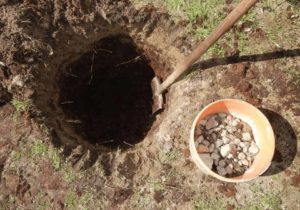
Now you need fill the hole to half or even higher with a fertile mixture (which one - read on).
How to fill the landing hole
So that the seedling can easily adapt to a new place, take root (take root) and begin to actively grow and develop, the planting hole is half filled (or better a little higher) with a nutritious substrate consisting of the following organic and mineral fertilizers:
- riding fertile soil (upper 20-30 cm), removed when digging a hole;
- 1-2 buckets of humus or compost;
Additionally:
- a bucket of non-acidic (deoxidized) peat (if you have sandy soil);
- a bucket of sand (if your soil is relatively heavy);
- phosphorus fertilizer: mineral - superphosphate (200-500 gr) or organic - bone meal (400-800 gr);
- potassium fertilizer: mineral - potassium sulfate (100-200 grams), organic analogue - woody ash (200-400 gr).
Either instead of superphosphate and potassium sulfate, just take 300-400 grams of nitroammophoska (it contains 16% nitrogen, phosphorus and potassium) or even better diammophoska (10:26:26).
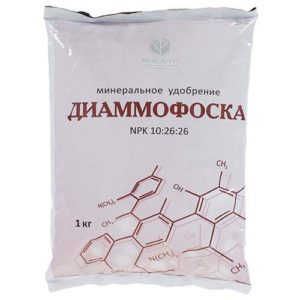
Pay Attention! When planting a tree, no need to addnitrogen fertilizers (urea, ammonium nitrate), since they stimulate vegetation (growth of green mass) to the detriment of root development.
Now you need everything to stir thoroughly (fertilizer, humus and garden soil), and then make a 3-5 centimeter pillow from the upper fertile soil (The fact is that humus and fertilizers during planting should not touch the roots, but be under the roots).
Important! Do not forget to leave fertile soil for further filling of the seedling.
After you fill the hole, in its middle you need drive in a wooden peg (1-1.2 meters high), which will further serve as a support for a young seedling.
If you do not tie a young seedling to a peg, then when leaves grow on it, due to the high windage, strong winds will sway the trunk and cut off young roots.
How deep to plant (how not to bury)
Everyone knows that a seedling cannot be buried, but what does this mean?
So, the first rule of planting - the seedling is placed in the planting hole to the root collar.
- What is the root collar?
This is the place of origin of the first root from the trunk, in other words, the place of transition of the trunk to the root.
Important! Wherein do not confuse root collar with grafting, which is always located above the root collar (usually 5-20 cm).
Respectively, vaccination site when landing, also should be above the ground (at least 5 cm).
- How not to deepen the root collar?
In order not to exactly deepen the root collar, it is necessary to initially place it just above the soil surface (as a rule, on average 3-5 cm will be enough; if the soil is very loose and not compacted, then 5-8 cm is better). As a result, after the tree settles in the soil, the root collar itself will take its normal position, i.e. will be flush with the soil or slightly below.
Advice! At the same time, it is convenient to control the landing level with a rail (or a shovel handle), which must be placed horizontally on the sides of the pit.
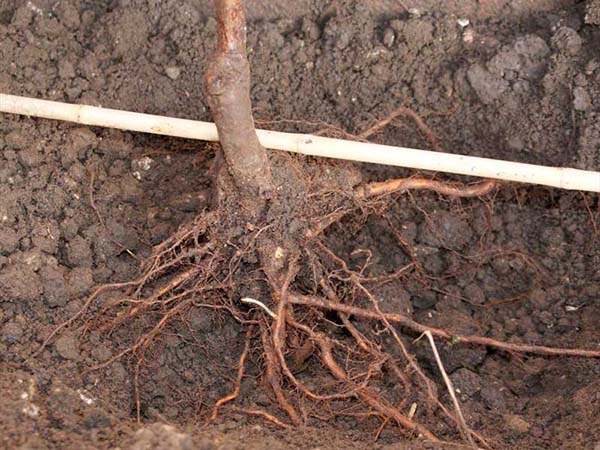
Important! The most common reason for deepening is planting a seedling in a freshly prepared (filled with loose soil) planting hole, due to which the root collar can be pulled into the ground by 1/5 of the planting hole depth (respectively, at a depth of 60 cm - by 12 cm!). That is why the planting hole must be prepared in advance (and well tamped the soil) so that the soil has time to settle.
- What is the danger of burying the root collar?
Deepening the seedling during planting will lead to a gradual podoprevanie bark (especially on heavy clay soils, where melt and rainwater lasts for a long time) and the death of the seedling. In any case, a buried seedling will develop very slowly, have a depressed appearance, give a weak growth, the leaves will be small and pale. At the same time, fruiting will not come very soon, and the yields themselves will be minimal.
However! You can't plant too high either. - the roots of the seedling will be bare and can simply dry out in the summer heat or freeze out in winter.
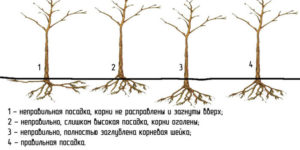
Therefore, it is very important to initially prevent burial.
If you nevertheless deeply deepened the root collar during planting (so to speak, it literally went underground), then you have no choice but to dig up and plant (transplant) the tree again.
Just do not dig out the earth from the trunk, there is no sense in this, only harm: moisture will stagnate in the deepening, which will also lead to podoprevanie bark.
Direct planting of a seedling in a hole
So, the planting hole is filled with a fertile mixture, about half or higher, and next to it there is a pile of fertile soil with which you will sprinkle the roots of the seedling.
We turn to the direct procedure for planting a fruit tree seedling:
- Pour a small mound in the center of the hole.
- Drive in a wooden support or a peg with a height of 1-1.2 meters (if you have not done this in advance).
It is better to hammer the peg right away, and only then bury the seedling, and not vice versa. Otherwise, there is a risk of injury to the roots.
- Place the seedling on a hill to the north of the peg, as close to the support as possible. Try on so that the root collar of the seedling is just above ground level.
If you have a seedling that was grafted with an eye (budding), then the budding site (eye = new shoot that grew from the grafting) should face north and the cut site should face south.
In this case, the peg should also be located on the south side of the seedling.
- Spread the roots of the seedling along its (mound) sides so that they (roots) look straight down (in no case should they be bent and stick up).
- Holding the seedling at the required height, carefully cover its roots with fertile soil, while sometimes shaking it so that the soil more densely fills the voids between the roots.
At the end, if you wish, you can slightly pull the seedling by the trunk a few centimeters up so that the roots take a more vertical position.
- Slightly compact the soil (you can use your hands).
- Make an irrigation hole along the perimeter of the trunk circle 7-10 cm high.
- Water (pour out 1-3 buckets of water). Wait for the water to be absorbed into the soil.
Watering is the best way to compact the soil.
- Fill up the fertile soil to the root collar (although the lower infertile soil layer will also go for filling).
- Now you carefully tamp the soil with your foot (putting your toe to the seedling), holding the seedling with your hand.
- Tie the seedling to the prepared support (peg) with a soft “figure eight” twine and fix it in the correct position.
If you tie it up before watering, the soil will settle and the garter will stretch.
- You mulch.
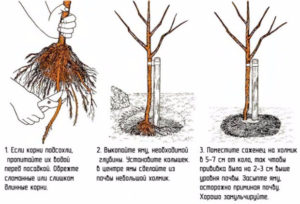
Video: planting seedlings in spring
Several controversial points and tips;
- When is the best time to water - before planting a seedling or after?
Most gardeners water after planting, but you can lightly shed a hole filled with nutrient soil before planting the seedling, and then after.
- Do I need to make a watering hole after planting?
Many recommend making 7-10 cm watering boards around the perimeter of the trunk circle.
However, it should be borne in mind that moisture will constantly accumulate and stagnate in the hole, which will cause the root collar to undergo heating.
Therefore, immediately after watering, when the water is completely absorbed, it is better to level the sides and loosen the soil in the trunk circle.
- Why and how to mulch the trunk circle?
Mulch will help prevent dry roots and excess moisture evaporation.
You can mulch sawdust, peat, humus or compost.
- How to mulch correctly?
Mulch should not be laid close to the stem of the seedling, as this can cause the bark to undermine. Wherein the grafting site should be above the mulch.
Pruning after planting
Immediately after planting, you need to level the aboveground (shoots) and underground parts of the seedling (roots).
How to trim?
- If the seedling was with an open root system, then pruning is required. You need to trim so that the main trunk remains 50-60 cm high, making a cut above the healthy kidney. If there are also side shoots on the main trunk, then they should also be shortened, leaving 2-3 buds each. If there are already leaves, then it is better to cut them off.
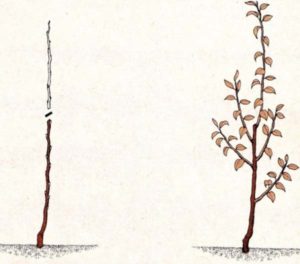
- If you are planting a container seedling, then you do not need to cut it off and leave the leaves, but at the same time it is imperative to water it in a timely manner and abundantly.
Features of planting a seedling in a container (with ZKS)
- A closed root seedling (CCS) does not require any preparation for planting (No root pruning required!), you just need to carefully remove it from the container without breaking the earthy coma.
- Then the seedling with the ZKS is carefully planted on a flat surface (not on a mound), being careful not to damage the earthen lump.
- As for the planting depth, the container seedling is planted flush with the ground.
- After landing pruning is optional, but watering regularly.
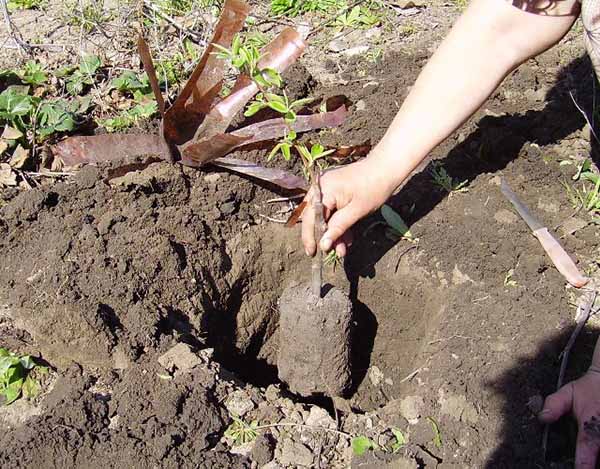
How to care for a seedling after planting
In the future, you will need a thorough post-plant care for young trees, aimed at creating optimal conditions for the early survival of the seedling.
First of all, you need to timely and regularly to water your young seedling.
If the weather is dry, then after planting the seedling should be watered at least once every 7-10 days, pouring out 2-3 buckets of water.
And after each watering (if you have not previously mulched it), so that an earthen crust does not form and to improve oxygen access to the roots, you need loosen trunk circle, as well weed, do not let the weeds grow.
Additional dressings over the next few years more not required, since you have already brought all the necessary food into the planting pit.
During the growing season, it is important follow behind the state of your tree, so that suddenly were not attacked by any pests (the same aphid) and / or did not hit dangerous fungal diseases.
And in the fall you need to carefully protect the tree from rodents (hares, mice), wrapping the lower part of the barrel with a special cloth or making a special protective structure.
In the future, the following will be included in the care of your fruit tree:
- watering, loosening and weeding (weed control), mulching;
- top dressing;
- trimming;
- treatment for diseases and pests;
Advice! The site already has general articles about when and how to spray an orchard early spring (eradication spraying), in spring and summer (before and after flowering) and in autumn (after harvest).
Correct and timely implementation of the above basic agrotechnical measures will contribute to the normal growth and development of your trees, as well as obtaining high annual yields.
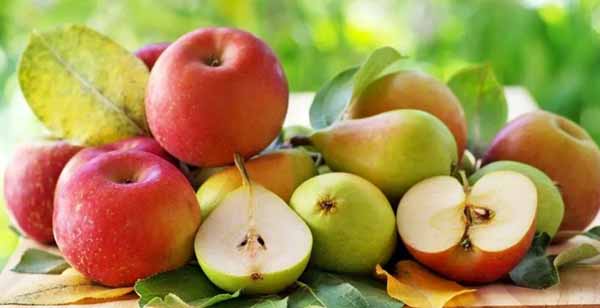
Well, that's all that a novice gardener should know, who has decided to lay an orchard on his site (or just plant a seedling). Good luck!
Video: rules for planting seedlings of apple, pear, cherry, plum


everything was told correctly and everything fit into my head thanks